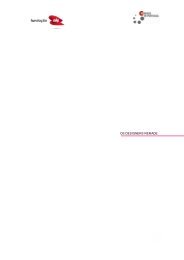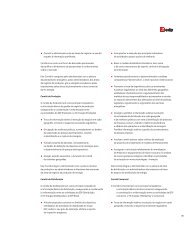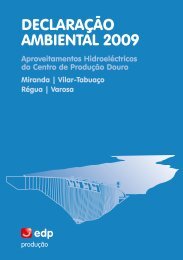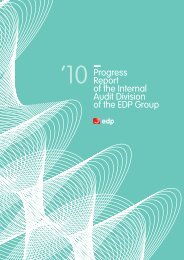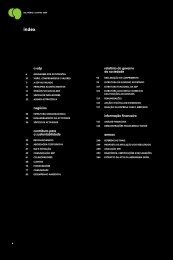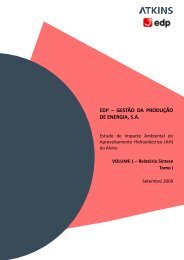Annual Report - EDP
Annual Report - EDP
Annual Report - EDP
- No tags were found...
You also want an ePaper? Increase the reach of your titles
YUMPU automatically turns print PDFs into web optimized ePapers that Google loves.
notes to the <strong>EDP</strong> consolidated - Energias de Portugal, and company S.A. financial statementsNotes to for the the Consolidated years and ended Company 31 december Financial Statements 2012 and 2011for the years ended 31 December 2012 and 2011The Portuguese wind sector and the Portuguese Government reached an agreement in principles that maintains the legal stability of the current contracts (Decree-Law 33-A/2005) and protects the value of the investments made by the wind energy producers in the Portuguese economy. The wind farm producers can voluntarilyinvest to obtain further remuneration stability, through a new tariff scheme to be applied upon the actual 15 years established by law. The total investment will be usedto reduce the overall costs of the Portuguese electricity system. In order to maximise the number of wind developers that voluntarily adheres to the extension of theremuneration framework, the Government proposed four alternative tariff schemes to be elected by each of the wind developers, that include the following conditions:i) alternative cap and floor selling prices; ii) alternative durations to the new scheme beyond the initial 15 years of the current contracts; and consequently iii) alternativelevels of investment (on a per MW basis) to adhere a new scheme. <strong>EDP</strong>R has chosen a 7 year extension of the tariff defined as the average market price of previoustwelve months, with a floor of 74€/MWh and a cap of 98€/MWh values updated with inflation from 2021 onwards, in exchange for a payment of 5.800€/MW from2013 to 2020.Regulatory framework for the activities in the United States of AmericaThe United States federal government and various state governments have been implementing policies to promote the growth of renewable energy, particularly windpower. The main federal renewable energy incentive program is the Production Tax Credit (PTC), which was created by the U.S. Congress as part of 1992 EPACT.Additionally, several states have passed legislation, mainly in the form of renewable portfolio standards (“RPS”), which require utilities to purchase a certainpercentage of their energy supply from renewable sources, similar to the Renewable Energy Directive in the EU.2. ACCOUNTING POLICIESa) Basis of presentationThe accompanying consolidated and company financial statements of <strong>EDP</strong> - Energias de Portugal, S.A. reflect the results of the company's operations and itssubsidiaries (<strong>EDP</strong> Group or Group) and the Group's interest in its associated companies, for the years 31 December 2012 and 2011.<strong>EDP</strong> S.A.'s Executive Board of Directors approved the consolidated and company financial statements (referred to as financial statements) on 5 March 2013. Thefinancial statements are presented in thousands of Euros, rounded to the nearest thousand.In accordance with Regulation (EC) 1606/2002 of the European Council and Parliament, of 19 July 2002, as transposed into Portuguese legislation through Decree-law35/2005 of 17 February, the company's financial statements and the Group's consolidated financial statements are prepared in accordance with InternationalFinancial <strong>Report</strong>ing Standards (IFRS), as endorsed by the European Union (E.U.). IFRS comprise accounting standards issued by the International Accounting StandardsBoard (IASB) as well as interpretations issued by the International Financial <strong>Report</strong>ing Interpretations Committee (IFRIC) and their predecessor bodies. The <strong>EDP</strong> Group'sconsolidated and company financial statements for the years ended 31 December 2012 and 2011 were prepared in accordance with IFRS as adopted by the E.U. until31 December 2012.The accounting policies used by the Group in preparing its accompanying consolidated financial statements as at 31 December 2012 are consistent with those used inpreparing the annual consolidated financial statements as at 31 December 2011.However, as described in note 50, the Group adopted in the preparation of consolidated financial statements as at 31 December 2012, the accounting standardsissued by IASB and IFRIC interpretations effective since 1 January 2012. The accounting policies used by the Group in preparing the consolidated financial statementsdescribed in this note were adopted in accordance. The adoption of these new standards and interpretations in 2012 did not have a significant impact on the Group'saccounts.The new standards and interpretations recently issued but not yet effective and that the Group has not yet applied on its consolidated financial statements, can also beanalysed in note 50.These financial statements also present the fourth quarter income statement of 2012 with comparative figures for the fourth quarter of previous year.The financial statements were prepared under the historical cost convention, modified by the application of the fair value accounting to derivative financialinstruments, financial assets and liabilities at fair value through profit or loss and available-for-sale investments, except those for which fair value is not available.Assets and liabilities that are hedged under hedge accounting are stated at fair value in respect of the hedged risk. Non-current assets and disposal groups held forsale are stated at the lower of carrying amount and fair value less costs to sell. Liabilities for defined benefit plans are recognised at the present value of the obligationnet of plan assets fair value.In accordance with IFRS 3 – Business Combinations, if the initial purchase price allocation of assets, liabilities and contingent liabilities acquired is identified asprovisional, in the subsequent 12 months after the business combination transaction, the legal acquirer should make the final allocation of the purchase price relatedto the fair value of the assets, liabilities and contingent acquired. These adjustments with impact on the amount of goodwill determined and booked in previousperiods, originates a restatement of the comparative information, which are refected on the Statement of financial postion, with effect from the date of the businesscombinations transactions liabilities.The preparation of financial statements in conformity with IFRS requires the Executive Board of Directors to make judgments, estimates and assumptions that affect theapplication of the accounting policies and the reported amounts of assets, liabilities, income and expenses. The estimates and related assumptions are based onhistorical experience and other factors that are believed to be reasonable under the circumstances, the results of which form the basis for making judgmentsregarding the carrying values of assets and liabilities that are not readily apparent from other sources. Actual results may differ from these estimates. The issuesinvolving a higher degree of judgment or complexity, or where assumptions and estimates are considered to be significant, are presented in note 3 (Criticalaccounting estimates and judgments in preparing the financial statements).Prior to 2012, amounts included in transaction costs related to institutional partnerships were included as a component of non-current Other debtors and other assets.In 2012, <strong>EDP</strong> Group included these transaction costs as a reduction of Institutional partnerships in USA wind farms instead of an asset. For consistency purposes, thispresentation has been applied to all statements of financial position presented (see note 38).Accounting policies have been applied consistently by all Group companies and in all periods presented in the consolidated financial statements.<strong>EDP</strong> - <strong>Annual</strong> <strong>Report</strong> 2012177







